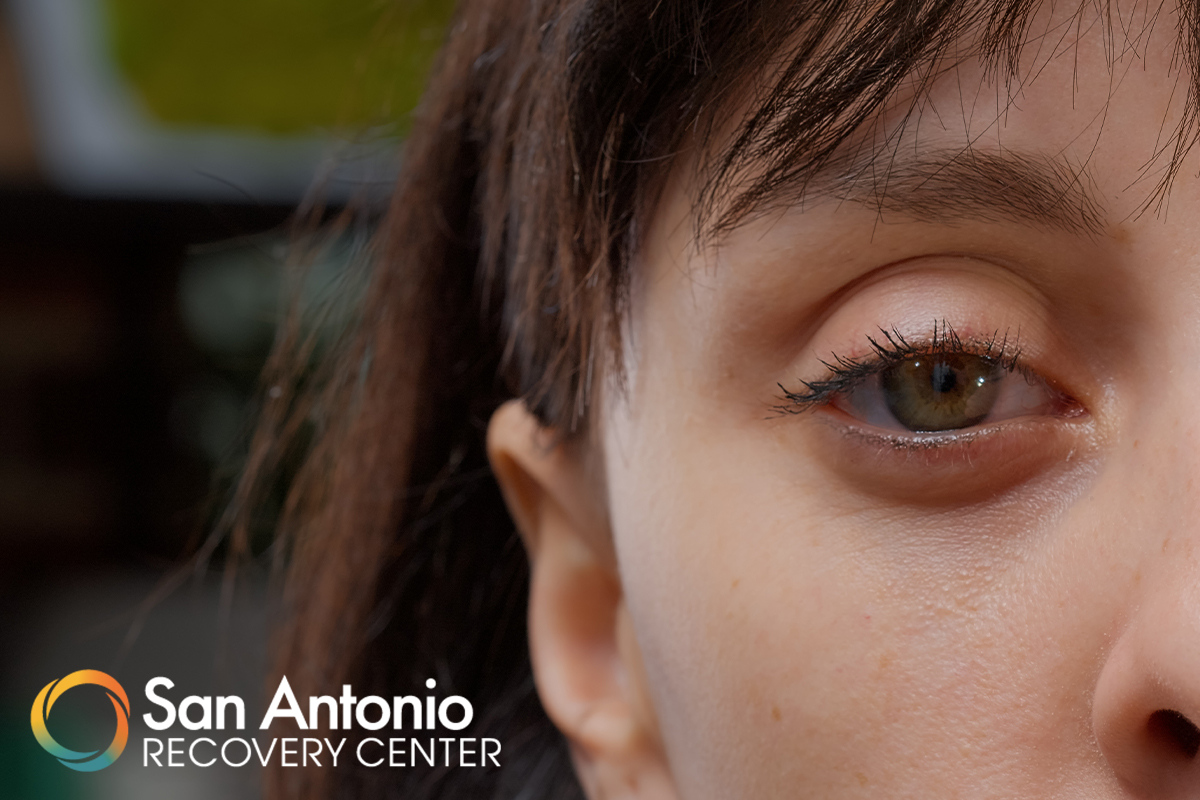
The government of Texas says we are going through an ”epidemic of drug poisoning”. So when you look over at your partner and see them sitting there, a glazed look in their eyes…it’s easy to worry.
One of the most common symptoms associated with substance use is this glassy-eyed look. But does this always mean they’re using a substance? And if they are, what could they be taking?
At San Antonio Recovery Center, we’re here to answer these questions. In this article, we’re going to cover the basics of why this happens, and let you know what drugs cause glassy eyes.
With substance use, the eyes can at times take on a glazed or even glassy appearance. This happens for a variety of reasons, most commonly as the result of chemical substances.
First, one common symptom of intoxication is that people blink less. When this happens, the eyes can begin to dry out. As the eyes dry out, their surface – usually a careful balance of oil and water – begins to reflect light differently. The eyes can even produce tears in an effort to keep the eyes moist, leading to a more reflective appearance.
Secondly, intoxication can cause the eyes to dull. As the body relaxes, the eyes can take on a stationary, almost lifeless appearance. Some individuals stare into the distance, or their eyes lose focus entirely. This effect only increases the “glassy” look. The more strongly intoxicated someone is, the more likely this is to happen.
Finally, other factors can influence the appearance of the eye. Many substances change blood pressure, causing the eyes to grow red or swollen, and pupils can dilate or become irritated. While these don’t necessarily cause the eyes to look glassy directly, the changes can bring attention to the eyes, highlighting an overall more glassy look.
Importantly, not all causes are from illicit substances. At times, prescription medications can lead to glassy eyes. Low blood sugar can cause these symptoms as well, alongside allergies or illness. Overall fatigue and tiredness can cause the eyes to unfocus, as can physical injury like concussion or migraines. Dehydration and vitamin deficiencies may lead to the same symptoms. So while glassy eyes can indicate substance use, other causes may be involved.

So which substances can lead to glassy eyes, specifically? What about their long-term impacts on eye health? Below, we touch on several of the most common sources of glassy eyes, and a few other substances as well.
While glassy eyes is a visual description, if your loved one ever becomes unresponsive, even with their eyes open, it is critical to seek immediate medical attention.
Alcohol is most traditionally associated with glassy eyes. The chemical shifts in the brain can lead to less blinking, creating a glass-like sheen on the eye. Alcohol can cause the eyes to unfocus, leading both to blurry vision and a “dull” appearance. In the long term, excessive alcohol use has been linked to increased cataract risk and other eye problems.
While marijuana is most commonly associated with red eyes, it can have a similar glassy effect to alcohol. In particular, it can lead to your loved one staring off into space, their eyes taking a dull and lifeless appearance. Marijuana is often prescribed to help with some medical conditions of the eye such as glaucoma, but in the long term marijuana use can lead to worsened vision and other eye problems.
Benzodiazepines are a wide category of prescription anti-anxiety drugs, typically going by brand names such as Xanax or Klonopin. These function similarly to alcohol, via a chemical known as GABA. This can lead to the same glassy appearance seen with alcohol consumption, even with legal prescriptions.
While every person’s response to a substance will be different, stimulants generally do not lead to glassy eyes. Where depressants such as alcohol or benzodiazepines cause the eyes to lose focus and become static, many stimulants have the opposite effect, leading to constantly moving and active eyes. Some individuals find themselves blinking excessively, which further reduces this glassy look.
However, despite the lack of a “glassy” appearance, these substances still impact the eyes and vision. Cocaine can lead to damage of the delicate blood vessels in and around the eye, with long term consequences to health and vision. Other stimulants such as methamphetamines are strongly linked with vision loss. Illicit substance use of any kind is dangerous, and if your loved one develops a substance use disorder, it is critical to get help and support for their recovery.

It’s often said that the eyes are windows to the soul. When your partner is living with a substance use disorder, it’s easy to see why. Whether their eyes are glassy and unfocused, or red and jittery, the effects of taking drugs can be visible and profound.
But professionals exist who are dedicated to treating this condition, and your family doesn’t have to go through it alone. Whether they need help getting back on track, or are only now starting out on their recovery journey, an effective drug rehab program might be the next step for your partner.
We believe that people are more than the substances they use. At San Antonio Recovery Center, our mission is to not only get your loved ones a path forward, but to stand by their side every step of the way. We have the largest alumni community in the region because we believe that recovery doesn’t end when you walk out the door. To take the first step, connect with us today at 866-957-7885, or through our website.
Strength. Acceptance. Recovery. Community.
contact us now!
